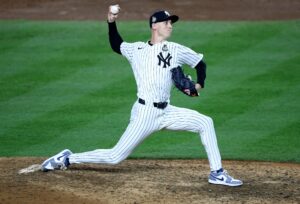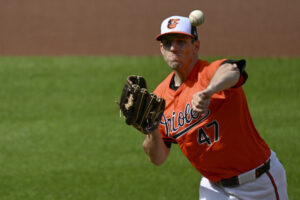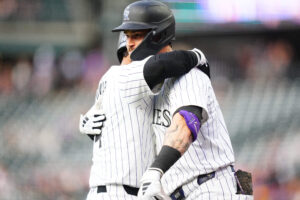Larry Walker Belongs in the Hall of Fame
Two weeks ago, three deserving candidates – Roy Halladay, Edgar Martinez, and Mariano Rivera – were elected to the Hall of Fame. Three borderline candidates – Harold Baines, Mike Mussina, and Lee Smith – will also be inducted this summer. Unfortunately, there were several deserving candidates who were not elected.
One is Larry Walker. Although he was one of the most feared hitters of the 1990s, he only has one more chance to be elected by the writers. This year, for the first time, he gained votes from more than half of the voters, but it was below the 75% threshold to gain induction. The voters have one more chance to get it right. Otherwise, he will languish in limbo until the Veterans Committee rightly votes him in.
Larry Walker in the Montréal Years
The main reason he has been snubbed is the fact that he played nine and a half of his 17 seasons in Denver. Yes, Coors Field is a hitter’s paradise, and he played there before they humidified the baseballs, but that is not a good enough reason to leave him out. After all, it’s not the only place he played. He played six seasons in Montréal before arriving in Colorado, and he had an outstanding season in 1994. In fact, he was one of several reasons that the Expos were heavy favorites to win the World Series that year before the strike halted the season early. Look at his numbers in 1994:
| Year | Tm | G | PA | AB | R | H | 2B | 3B | HR | RBI | SB | CS | BB | SO | BA | OBP | SLG | OPS | OPS+ | TB |
|---|---|---|---|---|---|---|---|---|---|---|---|---|---|---|---|---|---|---|---|---|
| 1994 | MON | 103 | 452 | 395 | 76 | 127 | 44 | 2 | 19 | 86 | 15 | 5 | 47 | 74 | .322 | .394 | .587 | .981 | 151 | 232 |
He led the league in doubles with 44, but that does not tell the entire story. What if the strike hadn’t happened? His 44 doubles came in only 452 plate appearances, a rate of roughly one double for every 10 plate appearances. Larry played in 103 games that year, averaging 4.38835 plate appearances per game played. The Expos played 114 games that year before the strike, so 48 were canceled. If his rate held steady, and if he played in all 48 of those games, he would have had roughly 211 more plate appearances. At his rate, he would have had 21 more doubles, giving him 65 for the year.
That is an insane number. It would have been the most doubles since 1936 and only two less than the Major League record, held by Earl Webb since 1931. In other words, he had a shot at breaking a 63-year-old record that still has yet to be broken. (The closest anyone has come since then is 59, which Todd Helton hit in 2000. By comparison, last year’s league leader – Alex Bregman – hit 51.)
The Coors Factor?
If he had only hit well because he played in Denver, his numbers would have skyrocketed immediately. As seen below, they did not. His average did not surpass his ’94 average until his incredible 1997 season.
| Year | Tm | G | PA | AB | R | H | 2B | 3B | HR | RBI | SB | CS | BB | SO | BA | OBP | SLG | OPS | OPS+ | TB |
|---|---|---|---|---|---|---|---|---|---|---|---|---|---|---|---|---|---|---|---|---|
| 1994 | MON | 103 | 452 | 395 | 76 | 127 | 44 | 2 | 19 | 86 | 15 | 5 | 47 | 74 | .322 | .394 | .587 | .981 | 151 | 232 |
| 1995 | COL | 131 | 562 | 494 | 96 | 151 | 31 | 5 | 36 | 101 | 16 | 3 | 49 | 72 | .306 | .381 | .607 | .988 | 131 | 300 |
| 1996 | COL | 83 | 304 | 272 | 58 | 75 | 18 | 4 | 18 | 58 | 18 | 2 | 20 | 58 | .276 | .342 | .570 | .912 | 116 | 155 |
| 1997 | COL | 153 | 664 | 568 | 143 | 208 | 46 | 4 | 49 | 130 | 33 | 8 | 78 | 90 | .366 | .452 | .720 | 1.172 | 178 | 409 |
Several sportswriters seem to forget that he played half of his games on the road, dismissing his offensive stats in the late 90s by saying that he would have been an average hitter at best if he didn’t play in Denver.
Is that true? Sabermetrics have created a statistic, park factor, that measures the impact of a stadium on batting or pitching numbers. A park with a rating of 100 is a completely neutral park, favoring neither pitchers nor hitters. If the rating is below 100, it favors pitchers; if it is above 100, it favors hitters. For reference, Coors Field hovered in the 120s while Walker played for the Rockies. During the same time period, Dodger Stadium, the most pitcher-friendly park in the league, had a rating in the low 90s.
Through Sabermetrics, one can adjust Walker’s hitting stats to a hitter-neutral environment. The results are fascinating. Yes, his average drops, but, as shown at the end of this writing, it still stands up against other Hall of Fame players.
Similarity Scores
Sabermetrics also has a statistic known as similarity scores. A player starts with 1,000 points. After running through a series of statistical comparisons, points are taken away based on the differences between the players’ numbers. The result is the similarity score. The highest similarity score for Walker is 888.9. The player? Duke Snider. Few, if any, baseball historians will argue his inclusion. Other Hall of Fame players in Walker’s top ten are Joe DiMaggio (865.4, fifth place), Johnny Mize and Vladimir Guerrero (tied for seventh with 860.2), and Chuck Klein (845.0, 10th place). Recent inductee Harold Baines, by comparison, had offensive numbers that were not as good as Walker’s, even after adjusting to a hitter-neutral environment. More on Baines in a minute.
Larry Walker Was More than a Hitter
Larry Walker was not just an offensive threat, winning seven Gold Gloves as a right fielder. He had a cannon for an arm, and in seven seasons between 1990 and 2002, he was among the top three right fielders in the league for outfield assists.
When defense is included, it becomes ludicrous that Baines is in while Walker isn’t. Baines played from 1980 to 2001. From ’87 onward, he was a full-time designated hitter. Of his 1,838 games from ’87 onward, he only played defense for as much as an inning in 81 of them. From ’93 to the end of his career, he played a grand total of two innings on defense. When he did play defense, people saw why he was a full-time designated hitter who never gained serious interest from a team in the National League.
The Art of Running the Bases
During an in-the-broadcast-booth interview, Scott Rolen said that Walker was the best player he ever played with. One reason that he immediately cited was baserunning. Numbers back this up. According to advanced baserunning statistics, 52% of the time that Walker was on base, he advanced more than one base on a single or more than two bases on a double. In 1997, that number was 70%. For comparison, here are the career percentages of other noteworthy runners: Rickey Henderson – 55%; Lou Brock – 54%; Vince Coleman – 53%. (Harold Baines, by the way, was at 37%.)
Larry Walker Belongs in the Hall of Fame
Walker was one of the best five-tool players of the past 30 years. Even though he did not reach any of the major counting milestones, he still struck terror into opposing teams and fans in the National League West any time he stepped to the plate. Had he not broken his clavicle and missed half the 1996 season, he almost certainly would have surpassed 400 homers. His injury came from crashing into the outfield fence while trying to make a running catch against the Atlanta Braves, which is no surprise to anyone who watched him play defense. His arm was a tremendous weapon, as was his base running. It is a crime that Walker is not in the Hall of Fame yet. Voters, do the right thing next year and vote him in.
| Year | G | PA | AB | R | H | 2B | 3B | HR | RBI | SB | BB | SO | BA | OBP | SLG | OPS |
|---|---|---|---|---|---|---|---|---|---|---|---|---|---|---|---|---|
| 22 Y | 2928 | 11392 | 10195 | 1319 | 2919 | 492 | 54 | 391 | 1636 | 38 | 1073 | 1489 | .286 | .352 | .460 | .812 |
| Year | G | PA | AB | R | H | 2B | 3B | HR | RBI | SB | BB | SO | BA | OBP | SLG | OPS |
|---|---|---|---|---|---|---|---|---|---|---|---|---|---|---|---|---|
| 18 Y | 2229 | 8407 | 7340 | 1205 | 2092 | 353 | 85 | 401 | 1277 | 98 | 962 | 1287 | .285 | .368 | .520 | .888 |
| Year | G | PA | AB | R | H | 2B | 3B | HR | RBI | SB | BB | SO | BA | OBP | SLG | OPS |
|---|---|---|---|---|---|---|---|---|---|---|---|---|---|---|---|---|
| 17 Y | 2046 | 7930 | 6894 | 1159 | 1994 | 444 | 57 | 348 | 1129 | 216 | 838 | 1270 | .289 | .373 | .522 | .895 |
Main Photo:
Embed from Getty Images






